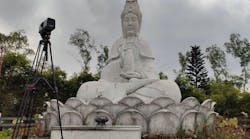Avalokitesvara: He who embodies compassion from all Buddhas. Revered in religions and beliefs ranging from Hinduism to Taoism, Avalokitesvara is known in many forms and by many names, from Tibet’s Chenrezig to Japan’s Kanzeon and India’s Padmapani. In Chinese Buddhism, this representation of compassion takes a female form: Guanyin, the Goddess of Mercy.
On special religious days celebrated in Buddhist communities around the world, statues of Guanyin are visited by many who come bearing gifts, offerings, and prayers, seeking blessings, good health, and spiritual guidance. While these statues are important cultural symbols, their placements can sometimes pose challenges. This was the situation for a statue of Guanyin that sits atop a mountain in Shenzhen, China, which recently faced the possibly seeing its final worshipers. With redevelopment fast on its way in the populous city and a lack of space in which to expand on, the well-visited statue needed a new home or face being destroyed.
Luckily, it was determined that the almost 50-ft tall statue would be moved to a new location instead of being destroyed. However, even with this decision, there’s a real possibility that the statue could be damaged during the relocation process. Within the local community, a group of employees at LK International, a 3D printing company, who regularly visit the statue wanted to preserve it digitally in its original form–peaceful and perfectly constructed atop a lotus flower, just in case there were any complications in moving the statue. Should the statue break or be damaged, having the digital scans would allow a replacement statue to be built with the same look and details.
LK International enlisted the help of 3D scanning reseller JIE Technologies to equip them with the right scanner to digitally capture the statue. JIE Technologies had just the scanner for an object of this size, intricate detail: Artec Ray. With the highest speed and accuracy among long-range 3D scanners, Artec Ray’s laser technology is ideal for capturing large objects such as airplanes, buildings, wind turbines or, in this case, a statue. The scanner can capture objects up to 110 m away, while objects within 15 m are scanned with submillimeter distance precision.
Ivan Fung, one of the JIE Technologies employees who worked on scanning the statue, said using the 3D scanner was a first for his team. Before the work began, the team practiced 3D scanning in their own homes, offices, and buildings. The team noted that the scanning was intuitive and was as easy as pressing a button.
“I’m an industrial guy, most of our scanning work is for industrial applications and reverse engineering,” Fung said. “We used Ray to scan the statue. It took four hours, which is really good for such an expansive statue.”
Using a construction lift to raise the scanner to various heights parallel to the ground, Artec Ray made its way around the statue. An iPad app was paired with the scanner for this project, making it easier to see what was being scanned in real-time. Following four hours of scanning, the data was processed and aligned in Artec Studio, in what Fung says was for himself and three colleagues, a day’s work. Being able to scan without using any targets, the team carried out less than 10 scans and during data processing, put them all together to create a full scan of the statue.
“If we needed to, we could have used another scanner to scan more details,” Fung said. “But actually, I was surprised that Ray scanned so well and captured all the necessary detail. Our customers are happy with the results of the scan, and we’re very satisfied, too.”
Today, even more has been done with the digital scan, even beyond the original goal of preservation. The original scan of Guanyin was scaled down to 10 to 15 cm and printed as keepsakes that are available for those who used to frequent the mountain.
Following the success of this 3D scanning project, JIE Technologies is confident they can use the technology to help other clients in China, such as museums or for architecture projects. With 3D scanning capabilities, the company is now well suited to help with cultural and historical preservation initiatives.
“In China, when the government or commercial investors want to use the land, it is sold for a higher price to make more money. This statue needed to be moved to make way for land development and modernization,” Fung said. “This happens quite often in China, and it’s good to protect some of our culture.”











